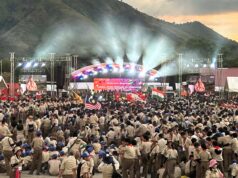SOME 30% of flights of turboprop planes will be moved from the Ninoy Aquino International Airport to the Clark International Airport or other secondary airports by March 30.
And by October 26, all turboprop operations of such scheduled domestic carriers at NAIA must have been completely transferred to other secondary airports.
So, it was announced this past week: the move-out-of-NAIA decision coming from the Manila Slot Coordination Committee composed of the Department of Transportation, Manila International Airport Authority, Civil Aviation Authority of the Philippines, Civil Aeronautics Board, and the New NAIA Infra Corp., the San Miguel Corp.-led operator of NAIA. This, to “efficiently and safely maximize the operations at the NAIA,” it was reported.
“Considering the limited capacity of the airport, parang, currently we’re running around 42 flights per hour po. So, you call it flight slots. Alam naman po natin, na pag turboprop po, mas maliit po yung passenger capacity ng eroplano,” noted MIAA head executive assistant Atty. Manuel Jeffrey David.
With 60-pax capacity, a turboprop airplane can reach regional destinations in the Philippines like Camiguin, Calbayog, Siargao, Masbate, Surigao, Busuanga, and Naga – which can only accommodate smaller aircraft, David said.
“So, by moving 30% of the capacity we also expect naman po na yung airlines natin would replace that with bigger airplanes, so mga A320s po that can accommodate more passengers,” he added. “So, by that, mas efficient po yung pagpapatakbo ng airport natin, mas marami po tayong maa-accommodate na pasahero.”
Not exact same words but all too similar a thesis already advanced almost exactly nine years ago – in February 2016 – by Alexander Sangalang Cauguiran, then in some sort of interregnum between immediate past EVP of the Clark International Airport Corp. and future CIAC president within that year.
Ex-CIAC exec: Transfer turboprop aircraft from Naia to Clark airport, headlined SunStar-Pampanga on Feb. 5, 2016. https://www.sunstar.com.ph/more-articles/ex-ciac-exec-transfer-turboprop-aircraft-from-naia-to-clark-airport
The lead paragraph quoting Cauguiran as saying “aircraft with turbo propeller (turboprop) engines will no longer be allowed to fly at the NAIA.” The turboprops contributing “to congestion of NAIA runway system, aircraft stands and parking bays.” Continued the story bylined John Kevin D. Pilapil:
“Turboprop aircraft, particularly those flying domestic routes, will enhance CRK’s ability to attract international legacy carriers as it ensures presence of feeder traffic and connectivity to other Philippine regions, he said.
Cauguiran said that NAIA has a runway capacity of 40 aircraft movement per hour but at certain hours, the airport services 46 to 48 aircraft per hour.
Clark airport’s runway capacity may easily be increased with the installation of additional aircraft stands and parking bays, according to Cauguiran.
There is also enough area inside the Clark aviation complex for a second runway that will allow simultaneous take-off and landing of aircraft, he added…”
The transfer of turboprops to the CRK is just one of the proposals embodied in the “Manifesto for the development of the CRK as major Philippine Gateway to Asia and the Pacific” by the Advocacy for Dual Airport Authority (Adapt) with Cauguiran as lead convenor, thus:
“Transfer all turboprop aircraft to Clark. Use of TPs contributes to congestion of MNL’s runway system, aircraft stands and parking bays while having lesser passenger bearing capacity. On the other hand, the transfer of TPs, particularly those plying domestic routes, will enhance CRK’s ability to attract international legacy carriers as it ensures presence of ‘feeder traffic’ and connectivity to other Philippine regions.”
The other proposals included: a) Legislate the NAIA-CRK Dual Airport System as a priority national policy and direct the Department of Transportation and Communications, Civil Aeronautics Board, and Civil Aviation Authority of the Philippines to establish and implement an Air Traffic Distribution Policy for Manila and Clark; b) Legislate the non-imposition (or moratorium on the collection) of travel tax in all airports of the Philippines except NAIA; c) Legislate exemption of Filipino airlines flying domestic routes (at all Philippine airports except NAIA) from payment of excise tax and value added tax on their aviation fuel; and d) Direct the Philippine Overseas Employment Administration, Overseas Workers Welfare Administration, Department of Health, and other government agencies to ensure that pre-employment procedures and services required of overseas Filipino workers are available near Clark airport (preferably under a One-Stop Government Center).
The Adapt manifesto was presented to then-as-now Senators Grace Poe and Chiz Escudero who were reported to have filed at the Senate a resolution expressing support to the development of the CRK along with the proposals from Cauguiran’s group and urged appropriate committees of the Upper House “to look into the matter with the end view of enacting legislative measures to address the same.”
Turboprops now moving to CRK, Alexander Cauguiran got the full affirmation of his steadfast seminal stand of nine years ago. This, even as it was during his watch as CIAC president-CEO that saw the blossoming of CRK, read: the coming of more flights, prior to its privatization.
Meanwhile, Noel Manankil, president and CEO of CRK operator LIPAD (Luzon International Premier Airport Development Corp.) is rolling out the red carpet: “CRK has the capacity to connect international travelers to our famed ‘island destinations’ with our transfer facility which is housed in the same terminal.”
Good job. Mr. Cauguiran.





